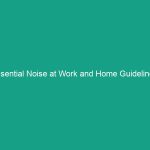“`html
Essential Noise Hazards and Control Guidelines to Protect Your Team
Good morning team,
Today, we’re going to discuss a critical aspect of Workplace Safety: noise hazards. Understanding and managing noise in our work Environment is vital not only for compliance with Safety regulations but also for protecting our health and well-being. Noise can be more than just an annoyance; it can lead to serious health issues, affect productivity, and impact our overall work experience. Let’s dive into why this topic is essential for us and how we can work together to mitigate these risks.
Understanding Essential Noise Hazards
Noise hazards refer to excessive or harmful levels of sound in the workplace that can lead to hearing loss and other health problems. Common sources of noise include machinery, tools, and even conversations in busy environments. The importance of addressing noise hazards cannot be overstated, as they directly affect our ability to communicate, concentrate, and perform tasks effectively.
Many employees might think that loud noise is simply a part of the job and that they have to accept it. However, this misconception can lead to chronic issues such as tinnitus or permanent hearing loss. It’s crucial to recognize that we have the power to make changes that protect our hearing health.
Key Hazards, Risks, and Safety Considerations
Let’s identify some specific hazards and risks associated with noise in our workplace:
- Prolonged Exposure: Continuous exposure to loud noise can result in noise-induced hearing loss (NIHL).
- Communication Barriers: High noise levels can hinder effective communication, leading to misunderstandings and accidents.
- Increased Stress: Constant noise can contribute to higher stress levels, affecting mental health and productivity.
- Physical Injuries: A noisy environment can distract employees, increasing the risk of accidents and injuries.
Ignoring these safety protocols can have real-world consequences. For instance, an employee may miss critical instructions due to noise, leading to a severe accident. We must recognize these risks and take proactive measures to ensure a safer workplace.
Best Practices, Procedures, & Actionable Advice
Here are some Best Practices and Procedures to minimize noise hazards:
- Conduct Regular Audits: Assess noise levels regularly using sound level meters.
- Implement Engineering Controls: Use quieter machinery or install noise barriers to reduce sound transmission.
- Provide Personal Protective Equipment (PPE): Ensure that employees have access to earplugs or earmuffs when noise levels exceed safe limits.
- Educate Employees: Conduct Training sessions to raise awareness about the risks and Safe Practices related to noise.
- Encourage Reporting: Create a culture where employees feel comfortable reporting high noise levels or related health concerns.
For example, in a previous project, a team implemented noise-dampening materials in their workspace, which significantly reduced overall noise levels and improved employee satisfaction and productivity. Such real-life examples can inspire us to take action in our environment.
Regulations, Standards, and Compliance
It’s essential to understand that noise control is not just a recommendation; it’s a requirement. The Occupational Safety and Health Administration (OSHA) sets permissible noise exposure limits, which are crucial for protecting employees. Additionally, ISO Standards also provide guidelines for managing noise in the workplace.
Compliance with these regulations is critical. It protects employees from hearing loss and potential legal issues for the company. By adhering to these standards, we demonstrate our commitment to a safe working environment.
Employee Engagement & Discussion
Now, I’d like to hear from you. What noise-related challenges have you encountered in your daily work? Have you experienced health issues due to noise? Let’s open the floor for discussion and share ideas on how we can improve our noise management strategies.
Conclusion & Key Takeaways
In conclusion, understanding essential noise hazards and implementing control guidelines is crucial for protecting our team. Remember the following key points:
- Noise hazards can significantly impact health and productivity.
- Proactive measures such as regular audits and proper PPE can mitigate risks.
- Compliance with osha and ISO regulations is essential for Workplace Safety.
Let’s prioritize safety and make our workplace a better environment for everyone. Thank you all for your attention and your commitment to maintaining a safe and healthy workplace.
“`


